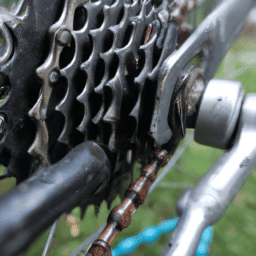For those who love cycling, the complex structure of a bicycle’s wheels holds a particular allure. Especially the spokes stand out for their essential function in keeping the wheel stable and properly shaped.
But have you ever wondered what bicycle spokes are made of and why certain materials are chosen over others? In this article, we will delve into the world of bicycle spokes, exploring traditional and modern materials, their pros and cons, and how to choose the right spokes for your bike.
When it comes to bicycle spokes, there is no one-size-fits-all solution. Each rider has different needs and preferences, and choosing the right spokes can make a significant difference in the performance of your bike.
Whether you’re a professional cyclist or a casual rider, understanding the materials and properties of spokes is essential for making informed decisions about your bike’s maintenance and upgrades.
So, let’s dive in and explore the fascinating world of bicycle spokes.
Key Takeaways
- Bicycle spokes can be made from various materials, including steel, aluminum, carbon fiber, and titanium alloys.
- The choice of spoke material depends on factors such as durability, weight, corrosion resistance, environmental impact, and rider preferences.
- Spoke tensioning and length are critical for maintaining bike performance and safety.
- Understanding spoke materials and properties is essential for informed bike maintenance and upgrades.
The Importance of Bicycle Spokes
You might not think about it often, but without sturdy spokes, your bike wouldn’t be able to handle the bumps and jolts of the road. Spokes are essential components of any bicycle wheel, as they play a crucial role in transferring load and providing stability while you ride.
In fact, the tension of the spokes is what keeps the wheel round and true, preventing it from wobbling or buckling under stress. Spoke tensioning is a critical aspect of maintaining your bike’s performance and ensuring that it remains safe to ride. By adjusting the tension of individual spokes, you can fine-tune the wheel’s stability and responsiveness, improving its ability to handle rough terrain or high-speed descents.
Additionally, different spoke patterns can affect the strength and durability of the wheel, with some designs providing more lateral rigidity and others offering greater torsional strength. Understanding the principles of spoke tensioning and pattern selection is key to optimizing your bike’s performance and longevity.
With that said, let’s take a closer look at the traditional materials used to make bicycle spokes.
Traditional Materials for Bicycle Spokes
Traditionally, metal alloys such as steel and aluminum have been the go-to materials for reinforcing the wheels of a bicycle. The spoke manufacturing process involves cutting, threading, and bending the metal into the desired shape.
Steel spokes are the most common choice for their durability and strength, while aluminum spokes are lighter and more corrosion-resistant. However, both materials have their drawbacks. Steel spokes are heavier and can add unnecessary weight to the bike, while aluminum spokes are more prone to fatigue and breakage.
The environmental impact of spoke materials should also be considered. Steel production is a major contributor to greenhouse gas emissions, while aluminum mining and processing can have negative impacts on local ecosystems. As a result, manufacturers are exploring alternative materials such as carbon fiber and titanium, which have lower environmental footprints and offer new design possibilities.
These materials will be discussed in the subsequent section about modern materials for bicycle spokes.
Modern Materials for Bicycle Spokes
Nowadays, there are newer materials to consider for your bike’s wheel reinforcements, such as carbon fiber alternatives and titanium alloys. These materials offer a few advantages over traditional metal alloys, such as lighter weight and increased eco-friendliness. However, there are some concerns about the durability of these materials compared to their metal counterparts.
To compare the properties of these materials, let’s take a look at a table of their characteristics:
| Material | Weight | Tensile Strength | Stiffness |
|---|---|---|---|
| Carbon Fiber | Light | High | High |
| Titanium Alloy | Light | High | Moderate |
As you can see, both carbon fiber and titanium alloys are lighter than traditional metal alloys, while still offering high tensile strength. Carbon fiber is particularly stiff, while titanium alloys fall in the moderate stiffness range. While these materials may be more expensive than traditional alloys, they offer unique advantages that may make them worth considering for your bike’s spokes.
Moving onto the next section about the pros and cons of different spoke materials, it’s important to consider the trade-offs between weight, strength, and cost when choosing the best materials for your bike’s wheels.
Pros and Cons of Different Spoke Materials
When considering the best materials for wheel reinforcements, it’s important to weigh the pros and cons of different options.
One of the most important factors to consider is the tradeoff between durability and weight. For example, spokes made of stainless steel are known for their strength and durability, but they can add significant weight to the wheel. On the other hand, spokes made of aluminum or carbon fiber are much lighter, but they may not be as strong as stainless steel and may require more frequent replacement.
Another important consideration is the environmental impact of different spoke materials. Stainless steel is a recyclable material, which makes it a more sustainable choice compared to aluminum or carbon fiber. However, the production of stainless steel can also have a significant environmental impact due to the energy and resources required in the manufacturing process.
Ultimately, the choice of spoke materials will depend on a variety of factors, including the rider’s preferences and needs, as well as the environmental impact of the chosen materials. With these factors in mind, it’s important to carefully consider all options before choosing the right spokes for your bike.
Choosing the Right Spokes for Your Bike
To ensure you have the best ride experience, it’s important that you choose the right type of reinforcements for your wheels. When choosing the right spokes for your bike, two crucial factors to consider are spoke tension and spoke length.
The correct spoke tension ensures that the wheel is strong enough to withstand the weight of the rider, while also providing the necessary stability and durability. It’s important to note that a higher tension generally results in a stronger and more durable wheel. However, the tension should not be too high, as this can cause the spokes to break.
On the other hand, the correct spoke length ensures that the spokes can be tightened to the correct tension and that the spokes fit correctly with the hub and rim. The spoke length should never be too long or too short, as this can cause the spokes to break or the wheel to become unstable.
Therefore, it’s important to choose spokes that are the correct length for your specific bike, as well as spokes that are made from high-quality materials such as stainless steel or titanium. By taking these factors into account, you can ensure that you choose the right spokes for your bike and enjoy a safe and comfortable ride.
Frequently Asked Questions
How do I know if my bicycle spokes need to be replaced?
To determine if my bicycle spokes need to be replaced, I inspect for signs of wear such as rust, bending, and broken spokes. I may also seek a professional assessment for proper diagnosis and replacement.
How do I properly maintain my bicycle spokes?
To maintain my bicycle spokes, I clean them weekly with a soft cloth and mild soap, avoiding harsh chemicals. I lubricate each spoke nipple with a drop of oil and inspect for loose or damaged spokes monthly.
Can I mix and match different types of spokes on my bike?
Imagine a wheel as a symphony: spokes are the musicians, each with their own unique sound. Spoke compatibility is crucial for a harmonious ride. Mixing spokes can lead to uneven tension and potentially fatal wheel failure. Stick to one type for optimal performance.
Are there any safety concerns with using certain types of spokes?
When selecting spokes, it’s important to consider their durability and corrosion resistance. Some types, like stainless steel and titanium, are more resistant to corrosion and can withstand greater tension. Lower quality spokes may break, causing safety concerns.
How do I determine the correct spoke length for my specific bike?
To determine the correct spoke length for my bike, I use the measuring technique of measuring the hub flange diameter and the effective rim diameter. I then adjust the spoke tension to ensure they are tight enough for optimal performance.
Conclusion
So, there you have it – the lowdown on what bicycle spokes are made of. As I delved deeper into the world of bikes, I was surprised to learn just how much difference the material of your spokes can make to your riding experience.
While traditional materials such as steel and brass have stood the test of time, modern materials such as carbon fiber and titanium offer a lighter, more durable option for those looking to take their cycling to the next level.
But at the end of the day, the choice of spokes ultimately comes down to personal preference and the type of riding you do. Whether you’re a casual weekend rider or a serious competitor, taking the time to research and choose the right spokes for your bike can make all the difference in your overall performance and enjoyment of cycling.
So, I encourage you to explore the world of bicycle spokes and find the perfect fit for your ride. Happy cycling!









